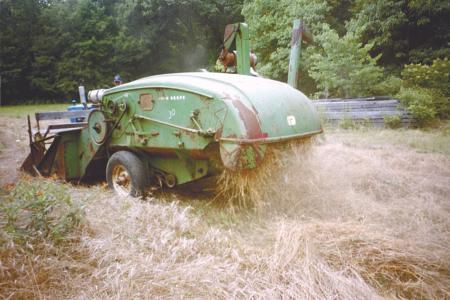
Havah Gordon has no time for expensive, imported, small-scale combines to
use on small acreages. When she wanted to harvest a few acres of wheat, she
bought a 1959 Deere 30 pull-type for $200.
“The combine had spent a lot of
time sitting, and I had to get inside to clean out all the nests and such,”
recalls Gordon. “I spent about a year fixing it up.”
She replaced most of the bushings
and bearings, a bunch of paddles, and even added a Hart Scour-Kleen grain
cleaner.
“For the first harvest I didn’t
have the cutter bar working, so we harvested the wheat with a sickle and
carried it to the combine to thresh it,” she relates.
By the next harvest, Gordon, who
works off the farm as an airplane mechanic, had the cutter bar working too. She
used it for one more harvest and then put the combine in storage.
“I fixed them up in the first place
to grow my own organic wheat,” says Gordon. “I had been having health problems
and hoped that would help solve it. By the third harvest, I discovered I had
Celiac disease so I couldn’t eat gluten-containing wheat. That was what was
causing my health problems.”
Gordon says the combine, and a
Deere drill she also restored, are sitting in her machine shed. “If someone gave
me $5,000 I’d load it all on a trailer,” she says.
While the combine required a lot of
parts and time, she says she actually spent more money repairing the drill,
including replacing tires.
“I paid $200 for a casting that
holds the cultivator wheel and the tube for the seed drop,” she recalls. “Then
I found a drill for parts, and now I have 60 to 70 extras.”
Finding combine parts was more time
consuming than costly. Other than a $15 link for a single no. 45 removable link
chain that is no longer available, most were inexpensive. Finding a second John
Deere 30 for parts helped.” I literally had to cut down trees to haul it away,”
says Gordon.
When she couldn’t find a Deere
grain cleaner, she found one built for an Allis Chalmers All-Crop at a Missouri
salvage yard. The main difference was the Deere unit sat to the rear of the
hopper while the Allis Chalmers unit was mounted at the front.
“I had to reverse a couple of
chutes that were just sheet metal,” she recalls. “I also needed screens and
found a guy on the internet who would make them.”
Gordon found the combine forum on
Yesteryear.com to be very helpful, both for parts and advice. She notes that
John Deere has an online parts counter for old tractors, combines and other
equipment.
“My combine cost me around $4,000
with parts, a couple of special tools, an original manual, and transportation
from Michigan to Oklahoma, where the farm was,” says Gordon. “That’s a whole
lot better than a new small-scale import for $55,000.”
